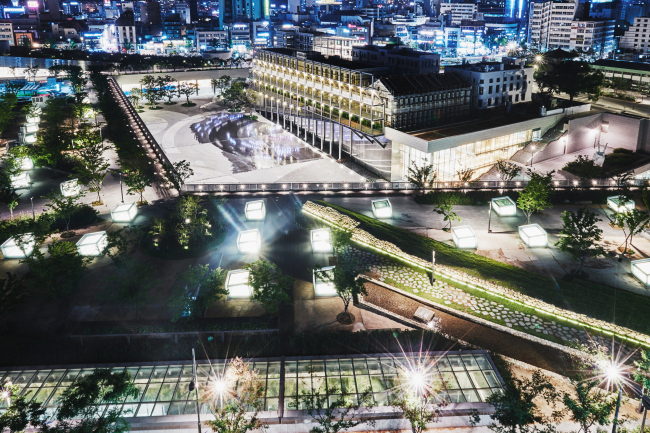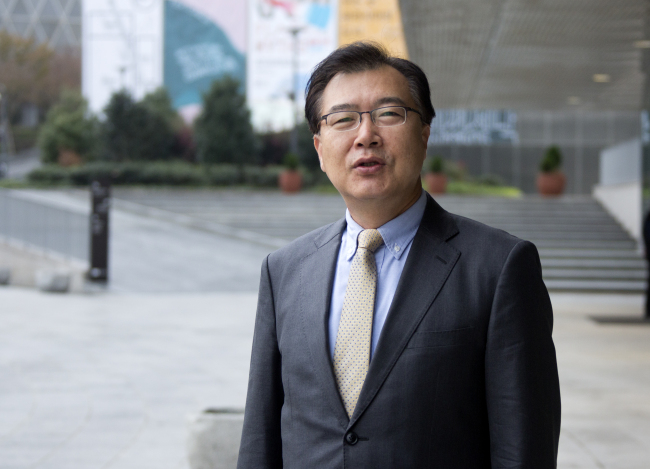Asia Culture Center to serve as ‘test bed’ for original content
By Park Hyung-kiPublished : Dec. 27, 2015 - 20:46

With its five interconnected buildings based on different yet synergistic and convergent themes, the Asia Culture Center strikes awe in visitors, who marvel at the architecture and the interior maze of exhibition and performance centers, artists’ studios, research centers and conference venues.
It would take a full day to enjoy all of the ACC’s programs and tour the buildings. The ACC consists of the ACC Creation, where artists can develop their ideas and stories; the ACC Archive & Research, where journals and published materials from around Asia are stored; ACC Children, where children can learn and take part in cultural programs; ACC Theatre, where artists can exhibit their work; and ACC Culture Exchange, where people can learn and view exhibitions about the May 18, 1980, Gwangju Democratic Uprising.
“The ACC will be a ‘test bed’ where both local and international artists can develop their ideas and experiment, creating works of art not only in Gwangju but also abroad,” said Bang Sun-gyu, acting president of the ACC, in an interview with The Korea Herald at his office in the culture complex, last Wednesday.
“The ACC is different from other exhibition halls. This is not a place where it just collects arts and shows to the public like others. We want to create an ecosystem focused on enabling artists to create original stories, or recreate or reinterpret traditional arts with modern technologies.”

Bang added that the ACC would be able to stand out in the region by being an artist-centered multicultural complex.
Fully equipped with what artists need to realize their ideas ― studios, materials, theaters, exhibition halls and archives ― what ACC is really trying to do is help create and tell “Asian stories” worldwide, Bang said.
“With its long history and traditions, Asia was never able to raise its voice or tell its stories on par with Europe,” said Bang.
“We offer a variety of programs both for artists, scholars and other people to share and develop ideas through public seminars, artists’ residencies and exhibitions.”
As a test bed, Bang hopes that art, content and stories “made in ACC” can be showcased and distributed not only in Gwangju but in Seoul and beyond. “One of the most important tasks for the ACC is expanding its networks and ties with overseas arts institutions, museums and galleries so that artists can get a chance to show and share their work overseas.”
The ACC’s operational concept ― enabling artists to create ― is very similar to the central government’s “cultural belt,” which includes a venture center and the K-Culture Valley in Seoul, where tech content start-ups can develop and commercialize stories.
“They are very similar, and both are bound to generate synergy in this field where the arts are increasingly converging with technology,” he said. “We also see a lot of opportunities to work with the private sector, to which the cultural arts sector can lend its artistic and design expertise in commercializing products. It would be a win-win for sure.”
The 158,700-square-meter ACC, which emulates a Hollywood movie studio lot, was opened to the public last month. Designed by architect Woo Kyu-sung, who is known for his involvement in the development of the Olympic Village for the 1988 Olympics, the complex is located below ground level, except for the ACC Culture Exchange Center. A park has been created on the top level of the ACC.
Under the slogan “Asia’s Cultural Window to the World,” the ACC, aims to become the cultural hub of Asia.
“We are currently moving into an age where culture, arts and content are becoming the main (growth) drivers of the economy,” Bang said.
By Park Hyong-ki (hkp@heraldcorp.com)
















![[KH Explains] Hyundai's full hybrid edge to pay off amid slow transition to pure EVs](http://res.heraldm.com/phpwas/restmb_idxmake.php?idx=652&simg=/content/image/2024/04/18/20240418050645_0.jpg&u=20240419100350)

